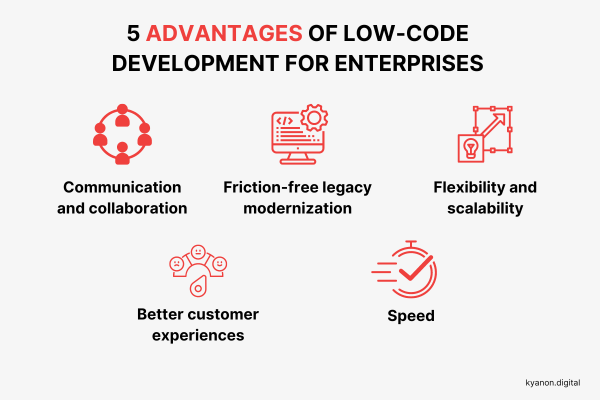Good Facts On Deciding On Low-Code Platform Sites
Wiki Article
Benefits Of Low Code Application Development In Terms Of Integration Capabilities
Low-code development is a fantastic method of creating applications that integrate seamlessly with various systems and services. Here are a few of the main benefits that come with Pre-built connectors and APIs.
A Wide Variety of Connectors: Low-code platforms typically come with a vast library of pre-built connectors for common enterprise software (e.g. CRM, ERP databases, cloud services, etc.). The process of integrating these systems is made simpler.
API Integration: Many platforms offer out-of-the box API integration capabilities. This lets developers quickly connect to external data and services.
Easy to make use of
Drag-and-Drop Integration: A variety of integration tasks can be accomplished using drag-and drop interfaces. This lets developers and non-developers to design complicated integrations using little or no programming.
Visual Workflow Builders: Tools for creating workflows and data flow which are visually represented help to understand and set up integrations in a much more simple way.
Standardized Integration Methods:
SOAP and RESTful Services: Support for standard web service protocols like REST and SOAP allows for easy integration with a array of external software and systems.
OData and other Standards Support for standards such as OData allows easy access and manipulation of data on various platforms and software.
Real-Time Data Synchronization:
Real-Time Integrations: Low-code platforms can handle real-time data sync between systems and applications. This guarantees that data is up to date and consistent throughout the organization.
Event-Driven Architecture: A few platforms have support for event-driven architectures, which allow applications to react to events in real time, which is essential for interactive and dynamic applications.
Legacy System Integration:
Low-code platforms are often utilized to integrate older systems. This enables organizations to modernize IT infrastructures without having to completely overhaul existing systems.
Data Migration: Built-in tools help transfer data from outdated applications to new ones that are built on platforms that use low-code.
Third-Party Service Integration:
Integration with Cloud Services: Seamless integration with cloud services like AWS, Azure, and Google Cloud allows for the simple deployment and scaling of applications.
Business Applications Integration: Low-code platforms can integrate with different business applications like Salesforce, SAP, Microsoft Dynamics, etc., enabling a cohesive workflow that is able to be used across various business functions.
Simplified management of data:
Unified Data Models: A few lowcode platforms have unification of coding models that simplify data management as well as integration and synchronization between various platforms.
Data Connectors Pre-configured data connectors make it easy to access and alter data from various sources.
Security and Compliance
Secure Integrations: Low-code platforms ensure that integrations adhere to security protocols and standards, helping to protect data during transit and in storage.
These platforms are usually packed with features to ensure compliance (e.g. HIPAA, GDPR) and provide peace of mind to businesses handling sensitive information.
Extensibility:
Custom Codes and Scripts. To meet more intricate requirements in integration, low-code platform often allows the inclusion custom scripts and code. This gives flexibility but without compromising user convenience.
Plug-in Ecosystem : An ecosystem of plugins and extensions can extend integration capabilities by allowing users to add new functionality as required.
Low-code platforms provide a powerful device to build interconnected, robust and scalable applications. These platforms simplify the process of connecting different IT systems, improve the flow of data, and aid businesses adopt existing technologies, while also leveraging new ones. View the most popular Low-code Platform for application development for site examples including rapid applications, mobile development platforms, azure sql databases, cross platform mobile dev, cross platform mobile app development, rapid action development, develop mobile application, app dev platform, rapid app development, develop web app and more.

Advantages Of Low-Code Application Development In Terms Of Flexibility And Scale
Low-code applications have a number of advantages when it comes to scalability. They are flexible and able to be adjusted to accommodate new needs. Three benefits are listed below.
Cloud-based deployment : Many low-code platforms are based. This lets applications expand seamlessly with the cloud infrastructure. This lets businesses handle the increased demand without worrying about managing servers.
Auto-Scaling: The auto-scaling function allows you to automatically adjust resources in accordance with demand. This guarantees consistent performance at peak times and without manual intervention.
Flexible Architecture:
Modular Design: Low-code systems encourage modular application design, where components can be independently developed, tested, and scaled. Modularity improves flexibility and it's easier to modify specific elements of an app without having to alter the entire system.
Integration of microservices: The ability to support microservices architecture allows applications to be designed as a collection of loosely linked services. This improves capacity and flexibility.
Custom-designed solutions:
Extensibility : Low-code platforms allow developers to enhance capabilities beyond what is available in standard features. It allows developers to meet their unique business requirements without any limitations.
Third-Party Integrations: The capability of companies to integrate third-party applications and APIs in addition to adding new features to their application when needed, enhances the capabilities of the application.
Agile Development and Deployment
Continuous Deployment and Delivery: Low-code platforms can be used to implement agile processes, allowing continuous deployment and integration (CI/CD). This allows rapid deployment of features and updates. Applications are then able to change quickly in response to market changes and feedback from users.
Iterative Development: Thanks to the iterative nature, low-code applications can scale and evolve slowly. This helps reduce the risk associated with significant changes and allows for greater control over expansion.
Resource Optimization
Low-code platforms can analyze and monitor the performance of applications, which helps to optimize the use of resources. This helps ensure that resources are utilized efficiently and are scalable to meet the actual demands.
Load Balancing: The integrated load balancing functions distribute the workload evenly across servers, enhancing the ability of the application to handle heavy traffic and ensure the same performance.
Global Reach
Multi-Region Deployment: Low-code platforms often support deployment across multiple geographical regions, which allows companies to offer low-latency connectivity to users worldwide. This is especially important for applications with a global user base.
Support for Localization: The built-in support of localization allows applications to be easily tailored for different languages and the requirements of diverse markets.
Updates and maintenance
Low-code software is visually appealing and are modularly built, which simplifies maintenance. Updates or bug fixes can be done quickly and without a lot of downtime.
Version Control: The integrated version control system helps keep track of changes and rollbacks. This makes sure that updates are easily implemented and earlier versions restored if required.
Cost Efficiency:
Low-code platforms can cut development costs because they eliminate the need for extensive programming. They also make it possible to expand applications without significant expenditure or effort.
Pay-As you Go Models Numerous platforms that are low-code users offer a variety of pricing options, including pay-as-you go model that aligns costs and usage with actual growth.
Low-code development provides businesses with numerous advantages, including scalability, flexibility and flexibility. This allows them to develop robust, flexible and scalable applications. These platforms provide quick responses to changes in needs, resource efficiency and constant improvements, which allows the application to expand as a company. See the recommended Enterprise application development with Low-code Platform url for website tips including rapid application design, develop mobile application, develop mobile application, developing mobile apps, app development platform, rapid applications, rapid action development, develop cross platform mobile app, cross platform mobile dev, lowcode no code and more.

Low-Code Apps Have Many Advantages In Terms Collaboration And Workflow
The low-code approach to development of applications offers a variety of advantages in terms of collaboration and workflow that make it a great choice for companies seeking to boost team productivity and speed up their development processes. Here are the key advantages: Improved Cross-Functional Collaboration:
Unified Development Environment : Low-code platforms offer a unified, single environment in which all team members can work together effectively, including designers, business analysts, and other stakeholders. This eliminates any silos.
Visual Development Tools Low-code platforms are simple to use, and come with a drag-and drop interface. This lets non-technical people on the team to take part in the development phase and ensures that business requirements can be captured in a precise manner.
Communication Enhancement
Real-time collaboration: A lot of low-code platforms offer real-time communication capabilities, such as simultaneous editing and commenting. Feedback is instantaneously provided. This helps to reduce the amount of time required to exchange information back and forth.
Shared Workspaces: Teams can work together in shared workspaces where they can view the, edit and debate aspects of projects, ensuring that everyone is on the same page and pursuing the same goals.
Streamlined workflow management:
Built-In Project Management Tools: Low-code platforms typically include integrated project management tools which help teams plan, track, and manage their development initiatives. This includes task assignment as well as progress tracking and deadline management.
Workflow Automation: Automation of repetitive tasks and workflows can reduce manual effort and errors which allows teams to concentrate on more strategic work and improving overall efficiency.
More efficient Iteration cycles
Rapid Prototyping Low-code platforms are perfect for rapid prototyping. Iterative development is also feasible, allowing the team to test, develop and improve their apps within shorter time. This means that feedback can be quickly integrated and improvements made rapidly.
Agile Development Support : Support of agile practices allows team members to develop sprints. They are able to continuously provide small increments in functionality, and more easily adapt to changing requirements.
Accessibility for non-developers
Citizen Development: Low-code platforms enable users in the business (citizens developers) to build and modify their applications without any prior knowledge of programming. This eases the burden on IT and development teams, and facilitates faster response to the business demands.
Training and onboarding: Intuitive user interfaces and extensive training materials aid in bringing new members of the team up to the speed of learning. This helps improve overall team's collaboration.
Centralized Documentation and Knowledge Sharing
Low-code platforms typically include tools for creating, managing and storing documentation within their platforms. This allows the entire project's information to be stored in a central location and easily accessible.
Knowledge Repositories: Teams are able to build and maintain knowledge repositories that contain best practices, templates, and reusable components, facilitating sharing of knowledge and reducing the repetition of efforts.
Standardization and Consistency:
Standardized Components. The commonality of components across various applications guarantees consistency and makes it easier to work and understand by team members.
Governance and compliance: Built-in frameworks for governance assure that all applications are designed in accordance with the organizational standards, regulations requirements, and the quality standards. They minimize the chance of not adhering to regulations and assure that applications meet the requirements of the standards.
Feedback and Improvement Loops:
Integrated Feedback Mechanisms Low-code platforms usually have integrated feedback mechanisms, allowing users to provide easy feedback on the application, which can later be integrated into the development process.
Continuous Improvement: The capability to quickly test and deploy changes based on feedback will ensure that the software is continuously improved, aligning closely with the goals and needs of users.
Visualization, Reporting and Analysis
Real-time Analytics: Built-in analysis and reporting provides real-time insights into project performance, user interactions and development. Data-driven decision-making is feasible.
Visual Workflow Maps Tools for mapping processes or workflows are helpful to teams in understanding their workflows. They can also identify bottlenecks, and areas that need improvement.
The main benefits of low-code development in terms of workflow and collaboration lie in its ability to unite teams from different backgrounds as well as streamline communication and automate processes. This creates a collaborative, agile and efficient development environment that leads to more efficient and high-quality applications.
